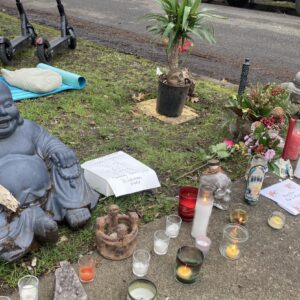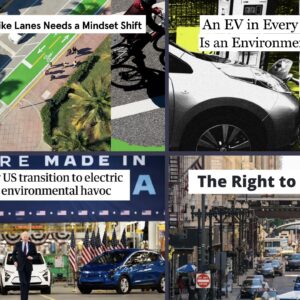
This morning I was on the XRAY in the Morning radio show and had a nice conversation with host DJ Ambush. He asked how I’m making sense of the intentional vehicular assault in Portland on January 25th and what we should do in response. I expected it would be a short exchange, but was pleasantly surprised that it went longer. DJ Ambush asked thoughtful questions and wanted to delve into the issue.
We talked for over 20 minutes. There is a short section in the middle where we talked about Congressman Earl Blumenauer’s new bike-related bills, but most of the conversation was about traffic violence, our dangerous car culture, and what we can do about.
You can check out the interview below:
Advertisement
And here’s the text (edited for brevity and clarity):
DJ Ambush: So the big news last week was a horrible tragedy that happened in the Buckman neighborhood, when the man intentionally ran his car into 10 pedestrians. How have you been making meaning out of such a terrible act of violence?
I’ve been doing a lot of different things. Part of it is really zooming in closely to what happened. I went out to a vigil that took place for the one woman Jean Gerich, who was killed two Monday’s ago to talk to her neighbors and friends and I actually met some of her family members… Zooming in closely and trying to really feel what happened is important. At the same time, I think, zooming out and thinking of the bigger picture of what’s going on in Portland, and possibly, what can we do for events like this, and people like this Paul Rivas person who used his car as a weapon and wanted to kill people with it?
Still so unbelievable, really. Are there any initiatives and things that you were working on that you think could have been helpful at all? Are there things that maybe sprung up as a result of this incident Things that maybe moved to the front of the front of your desk?
I think there’s been some throwing hands up by local leaders and transportation officials, because there’s this idea that, ‘Well, there’s just nothing we can do. If one person decides to do this with their car, there’s no policy or street design that’s going to prevent this.’ And we’ve heard that kind of reaction around drunk driving and other things where there’s this idea that it’s an individual’s behavior. But I just don’t think we’re in a place to accept that answer anymore. And I don’t think we should accept that answer. We have a city that is able to do all sorts of marketing and culture change in other ways, and I think we need to work on doing that around traffic, culture and traffic civility in general. And of course there are tons of underlying issues here about why there’s someone in Portland like Mr. Rivas that actually ended up doing what he did.
In terms of initiatives, I’ve been talking to folks in City Hall and commissioner staff about just trying to think out of the box a little bit and be more innovative about how we can fortify our streets. What can we do to make our streets tougher to thwart people who want to use their cars like that. Or even driving down a neighborhood street and you’re on your phone being distracted, I mean, I think you also have potential to do a similarly terrible thing. I think we need to make our streets more robust to prevent this kind of stuff.
One thing I’ve been doing some reporting about are “green streets” which are those planters on the corners that are supposed to soak up stormwater. That’s a whole different pot of money than transportation money, and actually a big a big pot of money. But it’s handled by the bureau of environmental services instead of the bureau of transportation. So there’s discussions going on in the city about breaking down silos… People might have heard Commissioner Mapps say he wants to see bureaus work more collaboratively and I’ve been saying, ‘Hey, here’s a good opportunity. Let’s maybe think about when we’re spending a lot of money on a sewer project and putting in these green street planters, let’s think about how to how to do those in a way that adds as much protection as possible.’ Yesterday we shared a photo of one of those planters that basically swallowed up someone in their truck. They crashed into one of these big planters and it brought home the idea that those are actually really good at protecting sidewalks and protecting bike lanes.
I was happy to see last night that new transportation Commissioner Joanne Hardesty posted something on Twitter about the new leader of the United States Department of Transportation, and she was talking about how traffic deaths are preventable and encouraging him to adopt “zero traffic deaths” and she mentioned last week’s hit and run. So good to see that it’s on Hardesty’s radar.
Are there any other things outside of the green streets initiative that you think would be helpful?
I think reducing exposure to driving is really important. And I don’t mean by people not walking in their neighborhoods. I mean encouraging as few driving trips as possible. Every time someone in Portland decides to drive, our risk of someone driving recklessly or distracted or using their car as a weapon, goes up. What happened in Buckman should build urgency to encourage as many people as possible to use transit, or ride a bike if you can, and walk when you can — and then of course, design our neighborhoods and town centers in a way that makes makes those choices possible.
I got caught off guard by that suggestion. I’m always so eager to just hop in the car, and you know, appreciate the convenience of being able to get up and go. But yeah, you’re right, that definitely increases the probability of accidents in general: More people driving, more accidents.
Yes, and when you have a culture and a city and transportation policies and projects that are all basically heavily weighted toward the assumption, the default thinking that everybody’s going to drive, well, then people who drive kind of think that that’s the thing to do and there’s this level of entitlement and there’s this whole culture that goes along with driving a car. And I think for some folks that entitlement can lead to a feeling of power and a feeling of dominance. And then you mix that with our toxic traffic culture —we’ve been reporting for years about statements people make that make light of how fun it would be to “run over pedestrians” or “I just hate those cyclists on the street, I wish they’d get off the road,” and the rhetoric we heard and saw over the summer about people driving their car into into protesters in the street. So there’s a lot going on here culturally.
Advertisement
Has this type of thing with these traffic accidents and assaults been on the rise? Do you know any reasons why this could be happening?
It’s a question I don’t really like to answer because I do think it is going up. I’m always struggling to balance between getting people excited about, you know, walking, biking and taking scooters and stuff; but also being truthful about what’s really happening. And I think at this moment, we have to acknowledge that there are more people driving more recklessly.
There are fewer people out driving right now, which means the roads look bigger to people, and when the roads look bigger people fill that space with speed. That’s traffic engineering 101. But there’s also an extreme amount of anger and desperation and anxiety out there right now in our culture. When you think about folks sitting at home, most of the time they get in their car and it’s the one time they feel like they can, you know, maybe do something fun. And like I said before we have a really, unfortunately, toxic culture around driving in America. And maybe when you watch an ad before you get in your car and see someone going super fast and glorifying speed and illegal driving. Then you hop in your car, and you know, for someone in the wrong mindset, that can lead to bad outcome.
I think we need have our eyes wide open that this stuff is happening more. And I think if we just wish it away as a one-time thing that we “just can’t imagine” that’s certainly not going to help us prevent it from happening again. And that’s what I’m worried about. That’s why I’m trying to help folks connect some dots on maybe some more innovative ideas, ways to shake more money loose, so that we can actually fortify our neighborhoods against this stuff.
Right now we have a transportation Commissioner who came out seven days after she got the bureau and said she wants to create more carfree space downtown. And I think a lot of people are really excited about that. Every time someone gets in a car, our whole community’s risk goes up. So if we can create spaces in our city that are fortified and or, you know, just prohibit driving outright, I think that’s a good thing.
We are at a real inflection point in terms of traffic violence. I think Portland needs to be really, really careful right now and our leadership needs to be careful about how they talk about it. I was happy Commissioner Mapps referred to Monday’s violent incident as a “murder” during a city council meeting. I think that’s the kind of language we do need to use.
So yes, I’m worried about what’s happening, but I’m hopeful that people are finally starting to get it a little bit more and starting to understand how serious this is. And I hope the reaction is to not cower down and stay inside and think that ‘Oh, I’m just going to fortify my own personal space by getting in a big steel car and driving a bigger SUV.’ I hope people respond by saying, ‘No, hell no! We’re going to get out in the street and remind people that streets are full people in our cities about people having fun and meeting face to face and walk in and scootering and biking!’ So I’m hopeful that’s the way Portland’s going to respond.
Thanks for having me on XRAY!
— Jonathan Maus: (503) 706-8804, @jonathan_maus on Twitter and jonathan@bikeportland.org
— Get our headlines delivered to your inbox.
— Support this independent community media outlet with a one-time contribution or monthly subscription.






Thanks for reading.
BikePortland has served this community with independent community journalism since 2005. We rely on subscriptions from readers like you to survive. Your financial support is vital in keeping this valuable resource alive and well.
Please subscribe today to strengthen and expand our work.
Great conversation. It was revealing that the host was forced to reflect on their own sense of driver entitlement and that they did not know about things like e-assist Biketown bikes. I think this says less about the host and much more about PBOT and our leadership’s lack of education campaigns.
Anecdotally, in my own conversations with folks around town, I have found that the mystique of Portland’s stature as a biking town is present without an understanding of the deficiencies. In other words, folks seem to think (like I did before moving here in large part because of biking) that Portland is safe for people who ride bicycles. While I agree that Portland is in the top tier of biking cities in the USA we still fall far behind the great biking cities of the world.
Here’s to hoping the 2020s will bring a renaissance not just for people on bikes but all those who wish to move about without a car.
Jonathan, per the title…So is it really “car violence” or “driver violence”?
Thanks for addressing the issue of “driver entitlement.” Just returned from a lunchtime bike ride around my neighborhood and experienced driver entitlement / aggression when a driver in a red SUV (surprise?) honked at me aggressively for being stopped on the side of the road, after he was past me. It was the type of classic driver aggression that anyone who bikes experiences regularly. And of course Portland is one of the *BEST* places to cycle in the US, meaning that even the best place is still pretty bad. There’s so much work to do if we ever hope to change the culture of driver entitlement, which basically says that since a person is inside of a car or truck or SUV and surrounded by a steel cage and empowered by 300+ HP, that person can exercise power over others who not similarly equipped.